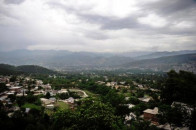Pakistan's depleted mangrove cover improving 'rapidly'
Mangrove cover expands by over 4 times in 2 decades, though experts voice concern on degradation

Pakistan's mangrove cover has seen rapid expansion along the Arabian Sea over the past two decades due to coordinated efforts by government agencies and environmental organizations.
Speaking to Anadolu Agency on the eve of the International Day for the Conservation of the Mangrove Ecosystem, which is celebrated on July 26 every year, Tahir Rasheed, a regional director of the World Wide Fund for Nature (WWF) Pakistan, said that in Southeast Asia, Pakistan is the only country where mangrove cover has increased dramatically over the last two decades.
Between 1999-2021, the vulnerable mangrove area along Pakistan’s 1,050-kilometer (652-mile) coastline has increased to over 200,000 hectares (over 494,000 acres) from 46,000 hectares (over a 113,000 acres).
A colossal chunk of mangrove forest falls in southern Sindh province, whereas southwestern Balochistan province, which boasts a 700-kilometer (435-mile) coastline, shares a meager portion of nearly 4,000 hectares.
“We witnessed a decline of mangrove forest from 600,000 hectares along the Sindh coastline in the early 20th century to merely 46,000 hectares in the mid-1980s. However, the cover area of mangroves has increased to over 200,000 hectares along the Sindh and Balochistan coastline over the past two decades,” Rasheed said.
Due to the “well-coordinated” plantation and rehabilitation campaigns by the Sindh Forest Department the federal government, WWF-Pakistan, and civil society organizations, the country’s mangrove cover is increasing at a “good pace,” he went on to say.
A host of projects by WWF-Pakistan alone have contributed 16,000 hectares to the country’s overall mangrove cover, apart from the rehabilitation of 32,000 hectares, he added.
Danger still lurking
Mangroves, a group of trees and shrubs that grow in the intertidal regions of tropical and subtropical coastlines, are significantly important for ecosystems and are considered the first line of defense against cyclones, strong surges, tsunamis, and other natural calamities.
The Sindh coast, particularly the port city of Karachi, has been reeling from a relentless process of morphological changes mainly due to anthropogenic activities including industrial pollution, soil erosion, deforestation, rapid industrialization, urbanization, and land degradation in addition to natural processes.
Industrial and economic infrastructure development, land-grabbing and inhabitation along the coast, and the construction of huts at beaches have adversely impacted the marine ecosystems and mangroves of the adjoining creeks, say environmentalists.
Making matters worse, some natural phenomena such as high energy waves, tidal currents, and strong winds during monsoons have also influenced changes along the coast.
Acknowledging a “rapid” increase in mangrove cover in the country, Hammad Gilani, a Lahore-based environmentalist, nonetheless observed that the danger is still lurking.
“Mangroves along Pakistan’s coastal belt and Indus Delta are still facing two key threats in the form of sea intrusion and degradation,” Gilani, a researcher at the International Water Management Institute in Lahore, told Anadolu Agency.
“Deforestation (of mangroves) is not a big problem. But degradation, which includes some justifiable livestock needs, is really an issue,” he argued.
He noted that rising sea levels have long been wreaking havoc on mangroves, especially in the Indus Delta, from where the Indus River flows into the Arabian Sea.
Also, mangroves require a systematic flow of fresh water, which unfortunately does not persist at the moment, he said.
Gilani noted that the South Asian country has seen a rapid augmentation in mangrove cover after the 2010 massive floods, which, although inundating a fifth of Pakistan, made up for a freshwater shortage.
Sharing a similar view, Rasheed said: "To keep the momentum going, we have to create awareness among the masses, and especially the policymakers, about the environmental significance of the mangroves and reinforce how important they are as the threat is not over yet."
Bulwark against sea battering
Thick mangroves have long protected Karachi and its coastal communities from erosion caused by the Arabian Sea's unending waves, observed Shabina Faraz, a Karachi-based expert, who often writes on the environment.
However, she added, the fragile ecosystem faces numerous threats, from coastal development, urbanization, and encroachment to the commercial exploitation of mangroves, reduction of freshwater flows and sedimentation, erosion of coastal areas, chemical dumping, and raw sewage.
"Karachi city alone contributes 500 million gallons of untreated water to the sea. Apart from that, polluted water from 6,000 industries also contributes high-impact pollutants to the Arabian sea that negatively affect the mangrove ecosystem and marine fauna," she maintained, speaking to Anadolu Agency.
Gilani, the Lahore-based expert, said that despite an increasing mangrove cover, satellite imagery has punctuated the need for national-scale carbon sequestration reporting for a performance-based payment mechanism flowing from developed countries to developing ones.
Seconding his view, Faraz said carbon sequestration reporting could add to the national economy "significantly."
Forests lose ground around Karachi
Tariq Alexander Qaiser, a Karachi-based environmentalist, said that although the mangrove cover on the wider delta was increasing, mature forests around Karachi have been pushed back.
Urban expansion into the estuaries and intertidal lands where the mangroves are found has had a negative environmental impact, he observed.
He said serious urban flooding had resulted from construction on flood plains, whereas water outflow into the sea had also been constricted, he told Anadolu Agency.
The dying of the plants' roots holding together the mud and sand on the islands and coast, Qaiser said, has allowed sands to shift and islands to erode.
This results in greater dredging needs, and increases costs of operating ports, he maintained.
"The removal of mangrove cover from the coastline also leaves the city vulnerable to sea surges and tsunamis. This has a serious impact on human life and safety."
According to Qaiser, the deltas' mangrove cover is expanding, but the situation is "very different" on the islands and shores of the cities, especially Karachi.
He explained that these "most mature and tallest of the forests" were being cut down due to poverty and the need for fuel.
The only way to retain this very necessary forest cover is to create and enforce a nature reserve on Karachi's Islands, Qaiser argued, adding that the metropolis, home to 20 million people, needed this oxygen-producing wilderness to maintain some control over its air quality.
"We need to keep planting new mangrove forests, but equally important is the need to protect the forests that exist. Especially on the islands of Karachi."



















COMMENTS
Comments are moderated and generally will be posted if they are on-topic and not abusive.
For more information, please see our Comments FAQ